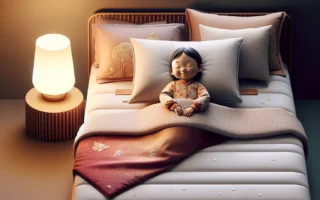Factors to Consider When Selecting a Kids Mattress
When it comes to choosing the best mattress for kids, there are several important factors to consider in order to ensure a comfortable and supportive sleep environment. One key factor to take into account is the firmness of the mattress. Children need proper support for their developing bodies, so it’s essential to select a mattress that provides adequate firmness to keep their spine aligned while also offering enough cushioning for comfort.
In addition to firmness, it’s crucial to consider the materials used in the mattress. Opt for hypoallergenic and non-toxic materials to minimize the risk of allergic reactions and exposure to harmful chemicals. Look for certifications such as CertiPUR-US or Oeko-Tex to ensure the mattress meets safety and environmental standards.
Another important aspect to think about is the size of the mattress. While a twin-size mattress is typically suitable for most children, consider the available space in the room and whether a larger option might be needed to accommodate growth or provide space for co-sleeping with a parent.
Furthermore, durability is a significant factor to keep in mind. A high-quality mattress constructed with durable materials will withstand the activities and movements of a child, ultimately extending its lifespan and providing long-term value.
Lastly, consider the breathability and temperature regulation of the mattress. Children can be sensitive to overheating during sleep, so choosing a mattress with proper airflow and cooling features can help ensure a restful and undisturbed night’s sleep.
By taking these factors into consideration, parents can make an informed decision when selecting a mattress that will promote healthy and rejuvenating sleep for their children.
The Importance of Proper Support and Comfort for Children’s Sleep
When it comes to choosing the best mattress for your kids, one of the most important factors to consider is the level of support and comfort it provides. Proper support is crucial for children’s growing bodies, as it helps promote healthy development and can prevent long-term issues such as back pain. Look for a mattress that offers adequate support for the spine, ensuring that it maintains a natural alignment during sleep.
Equally important is the comfort aspect of the mattress. Children need to feel comfortable and relaxed in order to get a good night’s sleep. Look for a mattress that provides a balance of comfort and support, with materials that contour to the body and alleviate pressure points. This can help prevent tossing and turning, allowing for a deeper and more restful sleep.
Memory foam and latex are popular choices for kids‘ mattresses as they offer both support and comfort. These materials adapt to the child’s body shape, providing personalized support while ensuring a cozy and snug sleeping environment. Additionally, consider the mattress firmness levels based on your child’s preferences and sleeping habits.
By prioritizing proper support and comfort when selecting a mattress for your child, you can contribute to their overall well-being and ensure they enjoy quality sleep for optimal growth and development.
Understanding Different Types of Kids Mattresses
When it comes to choosing the best mattress for your child, understanding the different types of kids mattresses is crucial. There are several options available in the market, each with its unique features and benefits. The most common types of kids mattresses include innerspring, foam, and hybrid mattresses.
Innerspring mattresses are constructed with a steel coil support system and provide excellent support and durability. These mattresses are also known for their good airflow, which can help in regulating the temperature and keeping the mattress cool. Foam mattresses, on the other hand, are made from different types of foam, such as memory foam or latex foam. They offer great comfort and pressure relief, making them suitable for kids who need extra support for their growing bodies.
Hybrid mattresses combine the support of innerspring coils with the comfort of foam layers. They often provide the best of both worlds, offering support, responsiveness, and comfort. Additionally, some mattresses are designed with organic and hypoallergenic materials, catering to children with allergies or sensitivities.
Understanding the differences between these types of mattresses can help parents make an informed decision based on their child’s specific needs and preferences. Factors such as support, comfort, durability, and temperature regulation should be taken into consideration when selecting the most suitable mattress for a child.
By understanding the distinct characteristics of innerspring, foam, hybrid, and organic mattresses, parents can ensure that they choose the best option for their child’s healthy sleep and overall well-being.
Tips for Maintaining and Caring for Your Child’s Mattress
When it comes to choosing the best mattress for your child, it’s equally important to focus on maintaining and caring for the mattress to ensure its longevity and your child’s comfort. Here are some essential tips for prolonging the life of your child’s mattress:
1. Invest in a quality mattress protector: A waterproof and hypoallergenic mattress protector can safeguard the mattress from spills, stains, and allergens, ultimately extending its lifespan.
2. Rotate the mattress regularly: To promote even wear and minimize body impressions, rotate the mattress every few months. This simple practice can prevent premature sagging and maintain the supportive qualities of the mattress.
3. Keep it clean: Regularly vacuuming the mattress can help remove dust, dead skin cells, and other debris that accumulate over time. In the case of spills or accidents, promptly spot clean the affected area following the manufacturer’s guidelines.
4. Air it out: Allowing the mattress to air out occasionally can help dissipate any trapped odors and moisture, keeping the mattress fresh and hygienic.
5. Follow manufacturer’s guidelines: Be sure to adhere to the care and maintenance instructions provided by the mattress manufacturer. This may include specific cleaning methods or recommendations for optimal use.
By implementing these practical tips, you can ensure that your child’s mattress remains in good condition, providing a comfortable and supportive sleep environment for years to come.



